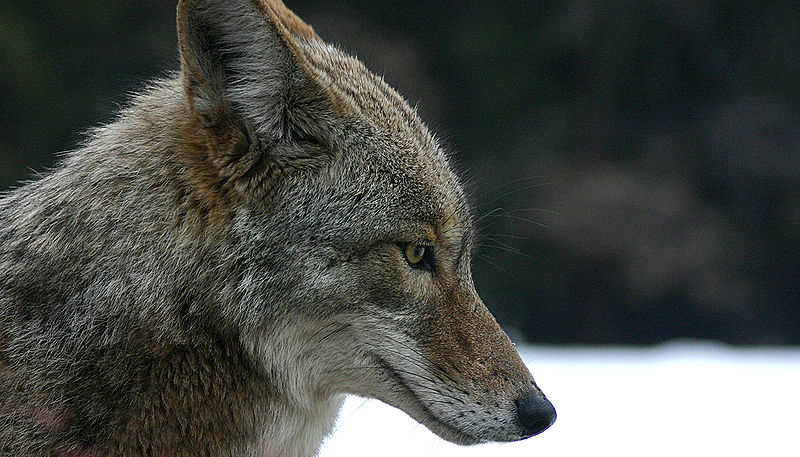

.
As residential development sprawls into the suburbs, complaints of contact with coyotes increases. Chattanooga, Tenn. resident Jerry Peyton has been noticing a trend for a year now and wrote in an e-mail, “Actually we have a family of coyotes that live in the neighborhood. It’s not that we are anti coyote, but the frisky little devils scare the folks and their kids.” Mr. Peyton pointed out that coyotes are becoming a “serious national problem!”
He seems to be correct in his analysis. Jacksonville, Florida (home of The Animal Channel), has had its share of coyote sightings at the beaches and in at least one Southside neighborhood. This past Fall, resident Raquel Rodriguez questioned if a loose dog was perhaps a coyote. While the animal in question was a wayward pet with a collar, her query underscores the confusion when domestic and wild life come into ever-closer contact. It was in late October when the Deerwood Country Club notified residents via e-mail about coyotes in the vicinity Mrs. Rodriguez said. She remembered reading that while one coyote could be a threat to cats and small dogs, the danger for humans grows when coyotes travel in packs. Shortly before receiving the e-mail, Mrs. Rodriguez said she saw a coyote traversing her backyard one evening. “It was a camel-colored animal waling a little fast,” she said. “The face was a little more pointed than a dog with a long tail held higher.” Mrs. Rodriguez said she has been living in Deerwood since the 1970s and never saw a coyote before. Also in October, Jacksonville DJ Robbie Rose told News4Jax that a coyote killed his cat. “Rose said unfortunately, coyote sightings and attacks on animals are becoming more of an issue in his neighborhood. He originally thought there was only one coyote involved,” wrote reporter Brittany Muller on the station’s website, “’Because that’s what I saw,’” Rose said. “’But these were working in a team. The cat didn’t have a chance.’" Emmy Tracy Carpenter of Ringgold, Ga. issued a warning for her neighbors on social media site Nextdoor. She wrote is a post that two to three coyotes killed a shrieking animal. “No dogs are missing, but have not heard any reports of any cats... It was frightening! Scared our dog and us, we were all inside and safe...” Singer LeAnn Rimes was not as lucky. On Feb. 9th several news outlets reported Ms. Rimes’ witnessed her dog mauled to death by a coyote on Feb. 7th.
Ironically, on Feb. 8th, The Florida Times-Union ran an article by Colleen Michelle Jones explaining that encounters with coyotes are relatively common. They have in fact been documented throughout the past decade. For example in a November 2011 article in the Resident Community News, Susan P. Barton explained that “Officials with the Florida Fish and Wildlife Conservation Commission are not surprised by reports of coyotes in a city setting. Spokesman Karen Parker said the commission has gotten reports of coyotes from all 67 counties in the state.” Those statistics are still true today, but St. Johns County Sheriff’s Office Spokesman Chuck Milligan maintains there is should be little to fear in coyotes. “’They are usually very shy and elusive and aren’t interested in humans …If you just kind of stand still, they’ll go away. They don’t look at you as prey and they don’t want to attack.’” In January, National Geographic reported on a new phenomenon—more blue-eyed coyotes, which is a rarity in the species. In natural selection, genetic mutations such as a change in eye color indicate adaptation to the surroundings, which for many wild animals are shrinking.
What has changed since Mrs. Rodriguez’s memories of the 1970s is of course the loss of land and habitat. For example, land behind the Rodriguez’s was once a field and forest. Now a dozen houses sit on the site. Ms. Jones’ research confirms the changes for both the human and coyote populations in an interview with Mark Middlebrook, executive director of the Timucuan Parks Foundation. “’Because we’re seeing more coyotes moving into urban areas, it’s wise to be aware of them and know how to deal with them,’” he said. Meanwhile in Chattanooga, residents are gathering photos and posting on such platforms as Facebook and Nextdoor. Mr. Peyton sees “Three options: The middle option would be most agreeable and pleasant to many people, so how does one learn to live with coyotes? And now a bobcat has been seen in Deerwood…
1.) kill them
2.) live with them
3.) move”
For more information, the following links can be helpful resources:
Living with Coyotes
Tennessee Wildlife Resources Agency
National Geographic
References
Barton, S. P. (2011, November ). Neighborhood wildlife abounds . Resident Community News, p. 10.
Broaddus, C. (2019, January). Mutant blue-eyed coyotes spreading through California. Retrieved from Naitional Geographic: https://www.nationalgeographic.com/animals/2019/01/blue-eyes-mutation-coyotes-spreading-in-california/?cmpid=org=ngp::mc=crm-email::src=ngp::cmp=Editorial::add=Animals_20190131::rid=16299185
En.wikipedia.org. (2019). Coyote portrait.jpg. [online] Available at: https://en.wikipedia.org/wiki/File:Coyote_portrait.jpg [Accessed 26 Feb. 2019].
Jones, C. M. (2019, February 8). Coyotes not an unfamilar sight across the county. The Florida Times-Union, p. B2.
Merrett, R. (2019, February 9). LeAnn Rimes' Dog Dies After Being Viciously Attacked by a Coyote in Front of Her. Retrieved from People.com: https://people.com/pets/leann-rimes-dog-dies-attacked-coyote/
Muller, B. (2018, October 24). Jacksonville DJ warns pet owners after coyotes kill family cat. Retrieved from news4jax.com: https://www.news4jax.com/news/pets/animals/jacksonville-dj-warns-pet-owners-after-coyotes-kill-family-cat